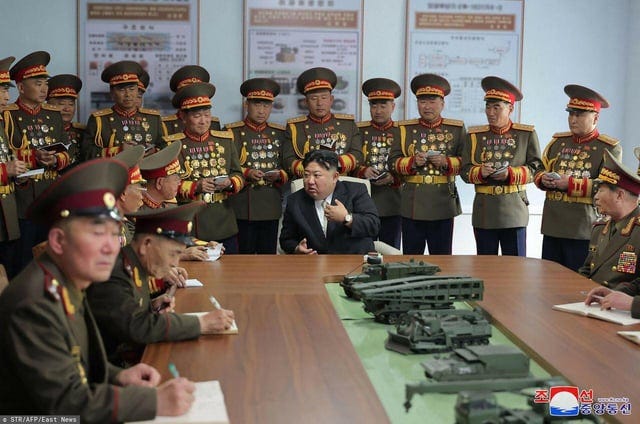Take Notes
Study.

How do you stay on beat?
Borrow One Idea: Take Notes
Write stuff down.
Not as a performative action because your life depends on it like a nKorean general, but as a personal action, entirely for yourself.
The military has green notebooks. The business world has moleskine. It all exists for a reason. To actually write in.


I like legal pads, but I’ve since progressed to a reMarkable to save space.
Whatever it takes, give yourself the opportunity to take notes.
AI has claimed ‘note-taking’ as a time consuming task to be removed from your plate, but delegating note taking is well along the slippery slope of disengagement. Relying on AI does not create individual knowledge, it merely provides a fact pact for later. A fact pact of limited value, because you failed to create your own mental reference points for the content.
There are two types of knowledge: tacit and explicit.
5-7. Tacit knowledge resides in an individual’s mind. It is the domain of individuals, not technology. All individuals have a unique, personal store of knowledge gained from life experiences, training, and formal and informal networks of friends and professional acquaintances. This knowledge includes learned nuances and workarounds. Intuition, mental agility, effective responses to crises, and the ability to adapt are also forms of tacit knowledge. Leaders use tacit knowledge to solve complex problems and make decisions. They also routinely engage subordinates’ tacit knowledge to improve organizational learning and enhance unit innovation and performance.
5-8. Explicit knowledge consists of written or otherwise documented information that can be organized, applied, and transferred using digital (such as computer files) or nondigital (such as paper) means. Explicit knowledge lends itself to rules, limits, and precise meanings. Examples of explicit knowledge include dictionaries, official department publications (such as field manuals, technical manuals, and Department of the Army pamphlets), and memorandums. Explicit knowledge is primarily used to support situational awareness and shared understanding as it applies to decision making.
FM 6-0, Sections 5-7 and 5-8, PDF page 94
Tacit knowledge is what is in your mind, but it also in what you write to yourself. Keeping notes for yourself is how you extend your repository of tacit knowledge. This is how you visualize your thoughts, connect dots, or create prompts to trigger your future self.
Be an engaged listener, get your synapses firing, write some stuff down. Actively build your repository of tacit knowledge.
This week, borrow with pride and take some hand-written notes. Write it down. Draw arrows connecting things. Scribble a few thoughts in a margin. Do you know how information sticks in your brain? What works best for staying in cadence with a project, team, or organization? How do you stay on beat?
Get Familiar With: Battle Rhythm
What’s your favorite rhythm related song?
The correct answer:
Back when songs had real lyrics.
Do you have rhythm?
The military has rhythm.
4-1. A headquarters’ battle rhythm consists of a series of meetings (to include working groups and boards), briefings, and other activities synchronized by time and purpose. The battle rhythm is a deliberate daily cycle of command, staff, and unit activities intended to synchronize current and future operations. … The COS or XO ensures activities are logically sequenced so that the output of one activity informs another activity’s inputs. This is important not only within the headquarters, but also in the unit’s battle rhythm as it nests with the higher echelon headquarters. The battle rhythm ensures that the staff provides the information pertinent to decisions and the recommendations on decisions made in the headquarters in a timely manner to influence the decision making of the higher echelon headquarters, where appropriate.
FM 6-0, Section 4-1, PDF page 67
Most every team, organization, household, and relationship has a rhythm. A beat. It helps everyone stay in cadence with each other. It keeps us in flow. It levels us emotionally, knowing where we are, the purpose of the moment, and what is next. Rhythm builds confidence and competence.
When there is no rhythm? Every day and every week feel like a mystery. What are we doing today? How does this help now? What is going to be next for us? An organization lacking rhythm, or which finds itself off-beat, is disjointed.
Rhythm is an outcome of deliberate choices, planning and consistent execution.
How do you stay on beat? Does your organization have rhythm? How do you create rhythm for your teams? Can a team be high performance without a consistent battle rhythm?
The Guided Discovery for this week will explore the concept of battle rhythm, how do establish a logical meeting cadence for leadership teams, and what is necessary to keep complex, multi-echelon organizations on beat.
Learn More: Suggested Reading
FM 6-0, Commander and Staff Organization and Operations
Pages 4-1 through 4-25 based on printed document (PDF pages 67-91)
Discussion of the processes and actions for effective and efficiency management of command posts
These materials will be the focus of Thursday’s Guided Discovery
Catch Up: Last Week’s Content
Study: Staff Duty
Guided Discovery: Continuous Command Post Operations
Always be asking:
1. What is the connection with my leadership development?
2. How does this change my thinking on management?
3. How does this influence planning for life?
4. What can I borrow with pride to use this week?

